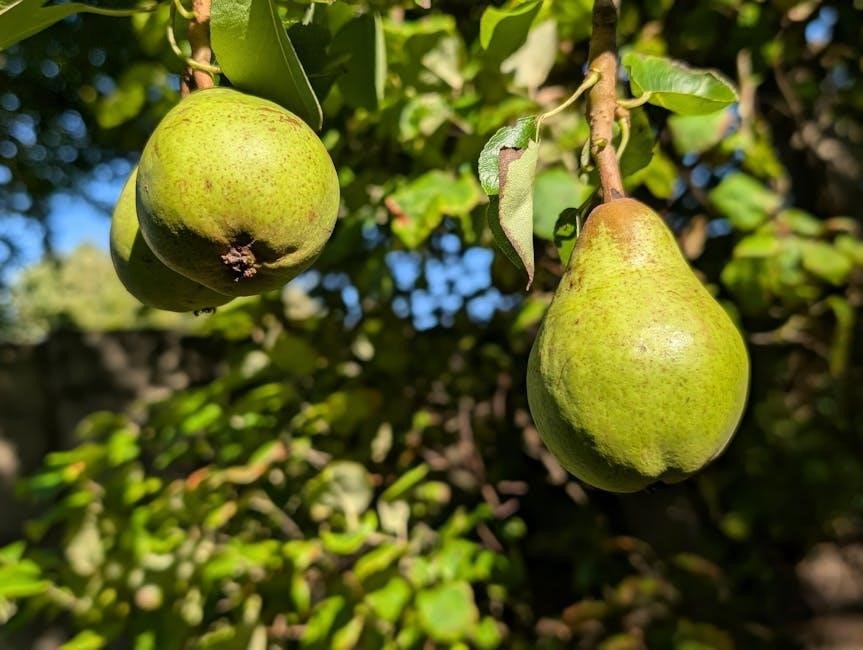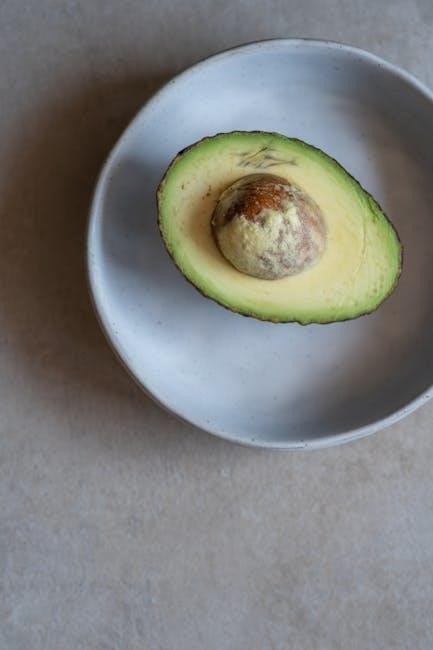A stomach ulcer diet focuses on managing symptoms, reducing inflammation, and promoting healing through dietary choices. It emphasizes bland foods, probiotics, and avoiding triggers to support digestive health effectively.
1.1 Understanding Stomach Ulcers and Their Causes
Stomach ulcers, also known as peptic ulcers, are painful sores that develop in the lining of the stomach or duodenum. They occur when stomach acid damages the protective mucous layer, often due to infections like H. pylori or long-term use of NSAIDs. Symptoms include burning pain, nausea, and bloating. Diet plays a crucial role in managing these ulcers by reducing acid production and avoiding irritants. Understanding the causes helps tailor dietary choices to promote healing and prevent recurrence. A well-designed diet can alleviate symptoms and support the body’s natural repair processes, making it a cornerstone of ulcer management.
1.2 The Role of Diet in Managing Stomach Ulcers
Diet plays a crucial role in managing stomach ulcers by reducing inflammation, preventing acid buildup, and promoting healing. A tailored diet helps avoid irritants that exacerbate symptoms, such as spicy or acidic foods. Incorporating bland foods, probiotics, and omega-3-rich items supports the stomach lining and combats harmful bacteria like H. pylori. A balanced diet not only alleviates discomfort but also enhances the effectiveness of medical treatments. By making informed dietary choices, individuals can manage symptoms, prevent recurrence, and improve overall digestive health, making diet a cornerstone in the holistic approach to treating stomach ulcers effectively.
Key Principles of a Stomach Ulcer Diet
A stomach ulcer diet focuses on reducing stomach acid, avoiding irritants, and incorporating healing foods to promote recovery and prevent recurrence effectively.
2.1 Reducing Stomach Acid Through Dietary Choices
Reducing stomach acid is crucial for managing ulcers. Certain foods naturally lower acid production or protect the stomach lining. Avoid acidic foods like citrus fruits and tomatoes, as well as spicy dishes, which can trigger acid secretion. Opt for alkaline foods such as bananas, melons, and green vegetables, which help neutralize stomach acid. Incorporating lean proteins like chicken or fish and whole grains can also support a low-acid diet. Avoiding caffeine and alcohol is essential, as they stimulate acid production. Drinking water between meals helps dilute stomach acid and prevent irritation. Portion control and eating smaller, frequent meals can further reduce symptoms and aid healing.
2.2 Avoiding Irritating Foods
Avoiding irritating foods is a cornerstone of managing stomach ulcers. Certain foods can exacerbate symptoms by irritating the stomach lining or increasing acid production. Spicy foods, acidic beverages like coffee and soda, and fatty or fried foods should be avoided as they can worsen discomfort. Additionally, alcohol and nicotine can impede healing and should be eliminated from the diet. Processed and sugary foods can also trigger inflammation, making ulcer symptoms more severe. Identifying and avoiding these triggers is essential for promoting healing and preventing further irritation. By focusing on bland, easily digestible foods, individuals can reduce discomfort and support their recovery effectively.
2.3 Incorporating Healing Foods
Incorporating healing foods is essential for managing stomach ulcers. Probiotic-rich foods like yogurt, miso, and sauerkraut help maintain gut health by fighting harmful bacteria. Omega-3 fatty acids found in fish, walnuts, and flaxseeds reduce inflammation, aiding in ulcer recovery. Bland foods such as bananas, oatmeal, and steamed vegetables are gentle on the stomach, minimizing irritation. These foods promote a conducive environment for healing and reduce discomfort, enabling the stomach lining to repair effectively without further aggravation.

Best Foods to Eat for Stomach Ulcers

The best foods for stomach ulcers include bland, non-irritating options like oatmeal, bananas, and steamed vegetables, along with probiotic-rich foods and omega-3 fatty acids for healing.
3.1 Bland Foods and Their Benefits
Bland foods are essential for managing stomach ulcers as they minimize irritation and reduce acid production. Examples include bananas, oatmeal, and steamed vegetables. These foods are gentle on the stomach lining, allowing it to heal without additional stress. Incorporating them into your diet can help alleviate symptoms like pain and discomfort. Bland foods are also low in acidity and fat, making digestion easier. By choosing these options, individuals with ulcers can create a soothing environment for their digestive system, promoting recovery and preventing further irritation.
3.2 Probiotic-Rich Foods for Gut Health
Probiotic-rich foods are crucial for gut health, as they promote a balanced digestive system and support healing. Foods like yogurt, miso, kimchi, sauerkraut, kombucha, and tempeh contain live cultures that introduce beneficial bacteria into the gut. These probiotics help combat harmful bacteria, such as H. pylori, which can cause ulcers. By improving gut flora, probiotics reduce inflammation and enhance the stomach lining’s ability to heal. Incorporating these foods into your diet can alleviate symptoms and create a protective barrier against further irritation, fostering a healthier digestive environment for recovery and long-term gut well-being.
3.3 Omega-3 Fatty Acids for Inflammation Reduction
Omega-3 fatty acids are renowned for their anti-inflammatory properties, making them beneficial in managing stomach ulcers. Found in foods like salmon, mackerel, walnuts, flaxseeds, and chia seeds, these fats help reduce inflammation in the stomach lining. By incorporating omega-3-rich foods into your diet, you can alleviate ulcer symptoms and promote healing. Their anti-inflammatory effects also support the stomach’s natural protective barriers, preventing further irritation and aiding in the recovery process. Regular consumption of omega-3s contributes to a balanced and resilient digestive system, making them a valuable component of a stomach-friendly diet.

Foods to Avoid with Stomach Ulcers
Certain foods can exacerbate stomach ulcers by increasing acid production or irritating the stomach lining. Common culprits include spicy, acidic, fried, high-fat, and sugary foods.
4.1 Spicy and Acidic Foods
Spicy and acidic foods can exacerbate stomach ulcers by irritating the stomach lining and increasing acid production. These foods can cause discomfort, heartburn, and worsen symptoms. Examples include citrus fruits, tomatoes, vinegar-based dressings, and spicy dishes like chili peppers or hot sauces. Reducing or avoiding these foods helps minimize irritation and allows the stomach lining to heal. Opting for milder alternatives, such as non-spicy seasonings or low-acid fruits like bananas, can help manage symptoms effectively while promoting a healing-friendly environment for the digestive system.
4.2 Fried and High-Fat Foods
Fried and high-fat foods can slow digestion and increase stomach acid production, worsening stomach ulcers. These foods are often difficult to digest, putting additional stress on the stomach lining. Examples include fried meats, processed snacks, and rich, fatty dishes. Consuming these foods can lead to prolonged discomfort and hinder the healing process. Incorporating lean proteins, baked or steamed options, and low-fat alternatives helps reduce irritation and supports a more balanced digestive environment, promoting recovery and symptom relief for those managing stomach ulcers.
4.3 Sugary and Processed Foods
Sugary and processed foods can exacerbate stomach ulcers by causing inflammation and irritation in the digestive tract. These foods often contain artificial additives and preservatives that can disrupt gut health, further aggravating symptoms. High sugar intake can also lead to an imbalance in gut bacteria, hindering the healing process. Avoiding foods like candy, baked goods, and processed snacks reduces irritation and supports a more stable digestive environment. Incorporating whole, nutrient-rich foods helps manage symptoms and promotes healing, making it essential to limit sugary and processed items in a stomach ulcer diet;
The Bland Diet Approach
A bland diet focuses on low-acid, low-fat, and minimally spiced foods to reduce inflammation and alleviate symptoms of ulcers, heartburn, and GERD, promoting gentle digestion.
5.1 What Constitutes a Bland Diet?
A bland diet consists of foods that are low in acid, fat, and spices to minimize stomach irritation. It includes non-acidic fruits like bananas and apples, steamed or cooked vegetables, lean proteins such as chicken or fish, and whole grains like rice or oatmeal. Dairy products like milk or yogurt are also included, provided they are low in fat. Foods high in sugar, processed items, and fried or fatty foods are avoided. The goal is to reduce inflammation and alleviate symptoms like heartburn and discomfort, promoting a gentle digestive process. This approach is often recommended for managing ulcers and gastritis effectively.
5.2 Sample Bland Diet Meal Ideas
A bland diet focuses on gentle, non-irritating foods. Breakfast options include oatmeal with bananas or scrambled eggs. For lunch, consider steamed vegetables like carrots or zucchini, paired with lean proteins such as grilled chicken or turkey. Dinner ideas might feature baked fish, mashed potatoes, or quinoa. Snacks like applesauce, yogurt, or toast are also suitable. Avoid spices, fats, and high-acid foods. These meals are designed to reduce stomach discomfort and promote healing while providing essential nutrients. They are simple to prepare and align with the principles of managing stomach ulcers effectively. Consistency in following this diet can lead to significant symptom relief and improved digestive health.

Probiotics and Their Role in Healing
Probiotics support gut health by balancing bacteria and reducing inflammation, which aids in healing stomach ulcers. They alleviate symptoms like bloating and discomfort, promoting a natural recovery process.
6.1 Foods Rich in Probiotics
Foods rich in probiotics, such as yogurt, miso, sauerkraut, and kimchi, contain live bacteria that support gut health. These foods can help reduce inflammation and promote healing in the stomach lining, making them beneficial for individuals with ulcers. Incorporating these into your diet can enhance digestion and strengthen the immune system, which is essential for combating harmful bacteria like H. pylori. Probiotic-rich foods are a natural way to restore gut balance, alleviate symptoms, and improve overall well-being, making them a key component of a stomach ulcer-friendly diet.
6.2 How Probiotics Fight H. pylori Bacteria
Probiotics play a crucial role in combating H. pylori bacteria, a primary cause of stomach ulcers. These beneficial bacteria help create an acidic environment that inhibits the growth of H. pylori. They also enhance the body’s immune response, stimulating the production of antibodies to fight the infection. Additionally, probiotics can reduce inflammation in the stomach lining, promoting healing and preventing further damage. By colonizing the gut, probiotics outcompete harmful bacteria, restoring microbial balance and aiding in the eradication of H. pylori. This natural approach can be a valuable complement to medical treatments, offering a safe and effective way to manage ulcers. Regular consumption supports long-term recovery and prevents recurrence.

Omega-3 Fatty Acids for Ulcer Management
Omega-3 fatty acids reduce inflammation, support stomach lining healing, and are beneficial for ulcer management, found in fatty fish like salmon and seeds like flaxseed and walnuts.
7.1 Sources of Omega-3s
Omega-3 fatty acids are abundant in fatty fish like salmon, mackerel, and sardines. Plant-based sources include walnuts, flaxseeds, chia seeds, and hemp seeds. These foods help reduce inflammation and support gut health, making them ideal for ulcer management. Incorporating these into meals can provide essential nutrients for healing and symptom relief. Regular consumption of omega-3 rich foods aids in soothing the stomach lining and promoting a balanced digestive system, which is crucial for individuals managing stomach ulcers. These sources are versatile and can be easily integrated into a diet plan tailored for ulcer recovery and long-term digestive wellness;
7.2 Anti-Inflammatory Properties of Omega-3s

Omega-3 fatty acids, particularly EPA and DHA, possess potent anti-inflammatory properties that play a crucial role in managing stomach ulcers. These fats help reduce inflammation in the stomach lining, which can exacerbate ulcer symptoms. By incorporating omega-3 rich foods like fatty fish, walnuts, and flaxseeds into the diet, individuals can alleviate irritation and promote healing. The anti-inflammatory effects of omega-3s also support the repair of the gastric mucosa, creating a protective barrier against stomach acid. This makes omega-3s a valuable component of a stomach ulcer diet, aiding in symptom relief and fostering a conducive environment for recovery and long-term digestive health.
A 7-Day Meal Plan for Stomach Ulcer Management
This structured meal plan provides balanced, gentle meals to manage symptoms and promote healing, focusing on bland, probiotic-rich, and omega-3 laden foods for optimal digestive health.
Start with bland, easily digestible foods to minimize stomach irritation. Breakfast: oatmeal with banana and a splash of low-fat milk. Lunch: steamed vegetables like carrots or zucchini with lean protein such as boiled chicken or fish. Snack: plain crackers with herbal tea. Dinner: mashed potatoes with a small portion of vegetable soup. Avoid spices, citrus, and fatty foods. Focus on small, frequent meals to ease digestion. Incorporate probiotic-rich foods like yogurt to support gut health. Stay hydrated with water or non-caffeinated, non-carbonated beverages. This day sets the foundation for a gentle, healing-focused diet.
8.2 Day 2: Incorporating Probiotics
Day 2 focuses on introducing probiotic-rich foods to promote gut health and combat harmful bacteria like H. pylori; Start with breakfast: plain yogurt with a drizzle of honey and a sprinkle of berries. For lunch, enjoy a mixed green salad with grilled chicken, topped with sauerkraut or kimchi. Snack on kefir or a small serving of miso soup. Dinner features steamed vegetables like spinach and carrots, paired with a side of quinoa and a small portion of tempeh. Probiotics help balance gut flora, reducing inflammation and aiding in ulcer healing. Ensure meals remain bland and avoid irritants like spices or citrus.

8.3 Day 3: Omega-3 Rich Meals
Day 3 emphasizes omega-3 fatty acids to reduce inflammation and support ulcer healing. Start with oatmeal topped with walnuts and chia seeds for breakfast. For lunch, enjoy baked salmon with steamed spinach and carrots. Snack on a handful of walnuts or add hemp seeds to a smoothie. Dinner features grilled mackerel with a side of quinoa and steamed broccoli. Omega-3s help alleviate inflammation in the stomach lining, promoting a healing environment. Ensure meals remain bland and avoid irritants like spices or citrus. Incorporating flaxseed oil in dressings or as a finishing drizzle can also boost omega-3 intake, aiding in recovery and symptom relief.
8.4 Day 4: Bland Diet Recipes
Day 4 focuses on bland, easily digestible meals to soothe the stomach. Breakfast includes oatmeal with mashed bananas and a drizzle of honey. Lunch features steamed chicken with cooked carrots and green beans, served with plain white rice. Snack on plain crackers or applesauce. Dinner consists of baked cod with a side of mashed potatoes and spinach. Avoid spices, citrus, and fatty foods. These recipes minimize irritation, allowing the stomach lining to heal. Ensure meals are low in acid and fat, focusing on gentle, non-irritating ingredients to maintain a soothing digestive environment and support ulcer recovery. Portion control and mild flavors are key.
8.5 Day 5: Avoiding Trigger Foods
Day 5 emphasizes identifying and eliminating trigger foods that can worsen ulcer symptoms. Common triggers include spicy, acidic, fried, and high-fat foods, as well as sugary and processed items. Avoid citrus fruits, tomatoes, chocolate, and caffeine, as they can irritate the stomach lining. Opt for bland, non-acidic options like bananas, applesauce, and plain toast. Stay hydrated with water or herbal teas, avoiding alcohol and carbonated drinks. By eliminating these triggers, you can reduce inflammation and alleviate discomfort, creating a more healing-friendly environment for your stomach. Focus on gentle, easily digestible meals to support recovery and prevent symptom flare-ups.
8.6 Day 6: Maintaining a Balanced Diet
On Day 6, focus on maintaining a balanced diet that supports healing while avoiding irritants. Incorporate lean proteins like chicken or fish, whole grains like oatmeal or brown rice, and non-acidic vegetables such as carrots or green beans. Include probiotic-rich foods like yogurt or kefir to promote gut health. Stay hydrated with water or herbal teas, avoiding alcohol and caffeine. Opt for healthy fats like olive oil or avocado in moderation. Avoid sugary and processed foods that can trigger inflammation. Ensure meals are well-rounded, with a variety of flavors and textures to keep the diet engaging while supporting your stomach’s recovery process.
8.7 Day 7: Review and Adjustment
On Day 7, review your progress and adjust the diet as needed. Assess which foods have helped reduce symptoms and which may still cause discomfort. Reflect on your eating habits and identify any triggers. Consult with a healthcare provider to discuss any lingering issues. Adjust portion sizes or food choices based on how your body has responded. Incorporate new recipes or foods that align with the diet plan. Track symptoms in a journal to monitor improvements and setbacks. Use this day to solidify habits and plan for long-term adherence to the stomach ulcer diet, ensuring continued healing and digestive well-being.
Lifestyle Changes to Complement the Diet

Lifestyle changes, such as stress management, avoiding alcohol and nicotine, and staying hydrated, support the healing process and enhance the effectiveness of the stomach ulcer diet plan.
9.1 Managing Stress
Managing stress is crucial for individuals with stomach ulcers, as stress can increase stomach acid production, worsening symptoms. Techniques like meditation, deep breathing, and yoga can help reduce stress levels. Additionally, engaging in regular physical activity and ensuring adequate sleep contributes to overall well-being. It’s important to identify and avoid stress triggers, such as a busy work schedule or personal issues, and seek relaxation methods that work best for you. Incorporating these practices into daily routines can complement the dietary changes and aid in the healing process. A stress-free environment supports the body’s natural ability to repair and recover from ulcers.
9.2 Avoiding Alcohol and Nicotine
Avoiding alcohol and nicotine is essential for managing stomach ulcers. Alcohol can irritate the stomach lining, increasing acid production and hindering the healing process. Nicotine, found in tobacco products, weakens the stomach’s protective barrier, making it more susceptible to ulcers. Both substances can delay recovery and worsen symptoms like heartburn and pain. Quitting smoking and limiting alcohol intake are strongly recommended to support the effectiveness of the stomach ulcer diet. Consulting a healthcare provider for assistance in quitting can significantly improve overall health and aid in ulcer management. Eliminating these habits complements dietary changes, promoting a faster and more effective recovery.
9.3 Staying Hydrated
Staying hydrated is crucial for overall health and particularly beneficial for managing stomach ulcers. Drinking plenty of water helps maintain stomach pH balance, prevents acid buildup, and aids in digestion. It also assists in keeping the stomach lining healthy, reducing irritation and inflammation. Aim to drink at least eight glasses of water daily, avoiding carbonated or caffeinated beverages that may irritate the stomach. Herbal teas, like chamomile or peppermint, can also be soothing and contribute to hydration without causing discomfort. Proper hydration supports the healing process and complements the dietary strategies outlined in the stomach ulcer diet plan.

Monitoring Progress and Adjusting the Diet
Regularly tracking symptoms and adjusting the diet ensures optimal healing. Keeping a food diary helps identify triggers and monitor improvements. Consulting a healthcare provider allows for personalized adjustments, enhancing the effectiveness of the stomach ulcer diet plan and promoting faster recovery.
10.1 Tracking Symptoms
Tracking symptoms is crucial for managing stomach ulcers effectively. By documenting episodes of pain, bloating, or nausea, individuals can identify patterns and triggers. A food diary can help pinpoint specific foods that worsen symptoms, enabling better dietary choices. Monitoring progress also allows for adjustments in the diet plan, ensuring it remains effective. Regularly reviewing symptoms helps in understanding what works and what doesn’t, fostering a more personalized approach to healing. This process aids in maintaining consistency with the stomach ulcer diet and supports overall recovery. Consistent tracking ensures that the diet evolves as symptoms improve or change, promoting long-term digestive health and well-being.
10.2 Consulting a Healthcare Provider
Consulting a healthcare provider is essential for managing stomach ulcers effectively. They can offer personalized dietary advice, monitor progress, and adjust treatment plans as needed. Regular check-ups ensure that the diet is aligned with individual health goals and symptoms are adequately controlled. A healthcare provider can also address concerns, provide additional resources, and recommend tests to assess healing progress. Their expertise helps in tailoring the stomach ulcer diet to specific needs, ensuring optimal recovery. By working closely with a healthcare provider, individuals can achieve better symptom management and long-term digestive health. This collaborative approach is vital for overcoming stomach ulcers and preventing recurrence.
A stomach ulcer diet is a crucial component in managing symptoms and promoting healing. By focusing on bland foods, probiotics, and omega-3 fatty acids, while avoiding triggers, individuals can alleviate discomfort and support recovery. Regular monitoring, lifestyle changes, and consulting healthcare providers further enhance the effectiveness of the diet; Adherence to these guidelines can lead to improved digestive health and reduced risk of complications. A well-planned diet not only aids in healing but also empowers individuals to take control of their condition, fostering long-term well-being and a higher quality of life. Consistency and patience are key to achieving optimal results with a stomach ulcer diet.